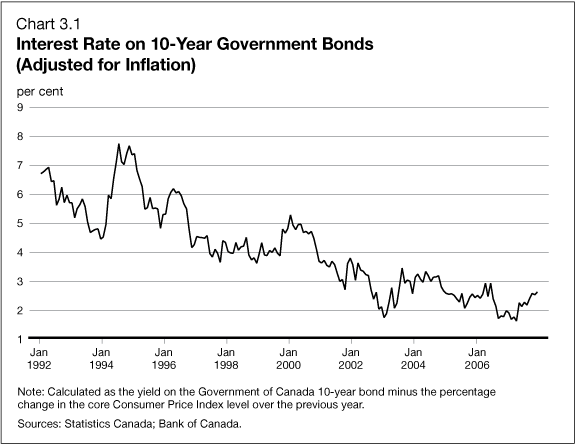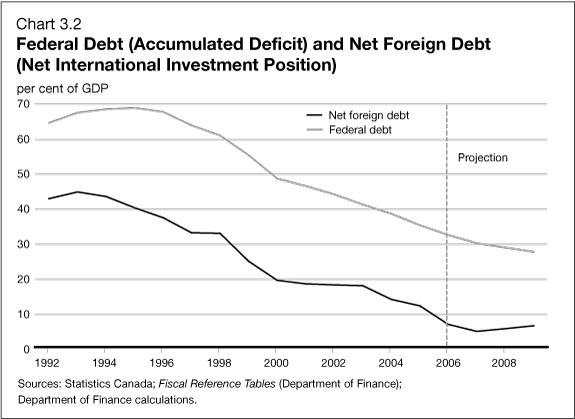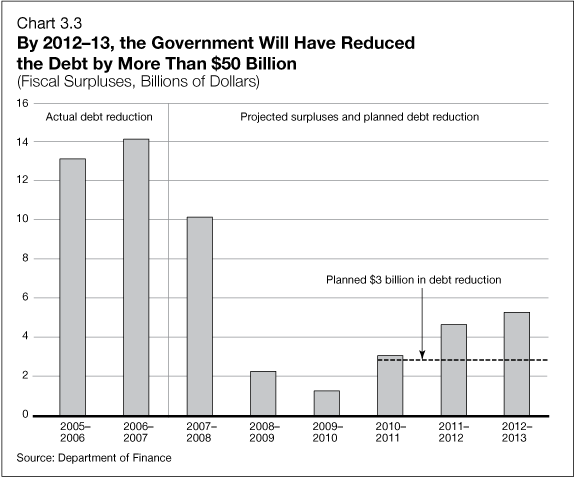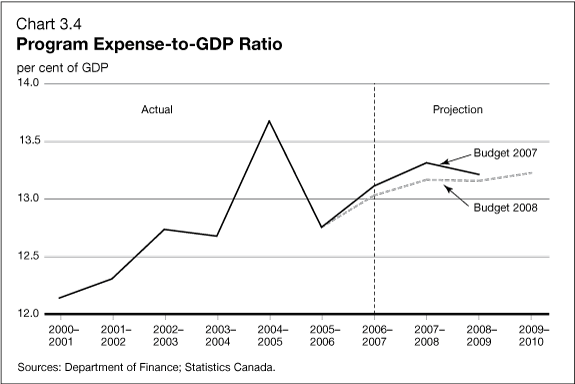Common menu bar links
Creating a Fiscal Advantage for Canada is a cornerstone of the Government’s long-term economic plan, Advantage Canada . By carefully managing spending and continuing to reduce debt, the Government will ensure that its programs provide value for money, are sustainable and keep the tax burden to a minimum. Budget 2008 builds on the Government’s record of strong fiscal management by:
- Reducing debt by $10.2 billion in 2007–08, and a total of $13.8 billion by 2009–10. By 2012–13, total debt reduction by the Government since coming into office will be more than $50 billion.
- Delivering on the Tax Back Guarantee by dedicating $2.0 billion in annual interest savings by 2009–10 to ongoing personal income tax reductions. This accounts for nearly 40 per cent of the personal income tax relief provided since Budget 2006.
- Continuing to implement the new Expenditure Management System by reviewing all departmental spending over a four-year cycle. The first round of these reviews included 17 federal organizations with spending of $13.6 billion. The savings realized are being used to fund new initiatives in these organizations and other priorities in this budget.
- Keeping spending focused and disciplined, with spending in 2007–08 and 2008–09 below the track set out in Budget 2007 in relation to the overall size of the economy.
- Focusing on core federal responsibilities while working with provinces, territories and other stakeholders to build a better future for Canada.
- Improving the management and governance of the Employment Insurance (EI) program through the creation of the Canada Employment Insurance Financing Board, an independent Crown corporation with a legislated structure which provides that EI premiums are dedicated exclusively to the EI program.
Strong fiscal management is the foundation of the Government’s economic plan. By carefully managing spending and continuing to reduce debt, the Government will ensure that its programs provide value for money and are sustainable over the long term, and that the burden of taxation is kept to a minimum. In the end, strong fiscal management leads to a higher standard of living for Canadians by reducing the share of tax dollars devoted to public debt charges and allowing monetary and fiscal policy to work together to control inflation and keep interest rates low.
The Benefits of Debt Reduction
The most direct benefit of lower debt is that less revenue is absorbed by interest charges, freeing up resources for more productive uses. To ensure that Canadians benefit directly from debt reduction, Budget 2007 legislated the Tax Back Guarantee. Under this Guarantee, the Government dedicates the effective interest savings from federal debt reduction each year to permanent and sustainable personal income tax reductions. Over time, the benefits provided under the Guarantee will grow. As of 2009–10, tax reductions provided under the Guarantee will amount to $2.0 billion. These savings have already been directed to personal income tax reductions set out in the October 2006 Tax Fairness Plan, in Budget 2007 and most recently in the 2007 Economic Statement. By 2009–10, the Guarantee will account for nearly 40 per cent of the personal income tax relief provided since Budget 2006.
| Table 3.1 Tax Back Guarantee (billions of dollars, unless otherwise indicated) |
|||
|---|---|---|---|
| 2007–08 | 2008–09 | 2009–10 | |
Total Tax Back Guarantee |
1.1 | 1.9 | 2.0 |
Personal income tax reductions provided in: |
|||
October 2006 Tax Fairness Plan |
1.1 | 1.1 | |
| Budget 2007 | 2.7 | 2.6 | 2.7 |
October 2007 Economic Statement |
3.5 | 1.9 | 1.3 |
Total personal income tax reductions |
7.2 | 5.6 | 5.1 |
Share of the personal income tax reductions |
|||
funded by the Tax Back Guarantee |
15% | 34% | 39% |
|
Note: The effective interest savings resulting from debt reduction are calculated as the reduction in federal debt multiplied by the average effective interest rate on the Government's unmatured debt. For example, the amount of the Guarantee in 2009–10 is equal to the interest savings from debt reduction up to 2008–09, which is about 5 per cent of $40 billion. |
|||
Low public debt also helps keep interest rates low. In the early 1990s, inflation-adjusted long-term interest rates averaged over 6 per cent, reflecting in part the risk posed to investors by the much higher level of indebtedness in Canada at that time. Since the Government sets the benchmark for all other borrowers in the economy—provincial and municipal governments, corporations and households—high federal debt imposes a significant cost on the economy. Higher borrowing costs led to lower private sector investment and a less productive economy.
Today, ongoing surpluses and falling Government of Canada debt help keep interest rates low (Chart 3.1). Inflation-adjusted long-term interest rates are currently just over 2 per cent. This makes it easier for Canadian corporations to raise funds to finance capital investment. This translates into higher private sector investment and a more vibrant, productive economy. Lower interest rates also mean significant savings for Canadian families when financing the purchase of large items such as a house. A Canadian family with an outstanding mortgage of $160,000 (amortized over 25 years) saves over $1,100 per year for each percentage point reduction in interest rates.

Lower debt levels also mean less reliance on borrowing from abroad (Chart 3.2). Rising debt and deficits pushed up net foreign indebtedness to more than 40 per cent of gross domestic product (GDP) in the early 1990s, with the result that an increasing share of income generated in Canada was flowing abroad to pay the interest on that foreign debt. Today, Canada has virtually eliminated its net foreign indebtedness. This means that a larger share of the income generated by the economy remains here in Canada. As described in Chapter 2, this has made an important contribution to the increase in the standard of living of Canadians since 2002.

Low debt levels also strengthen our ability to deal with economic shocks and challenges, such as the aging of the population. Debt represents a tax on future generations. Debt reduction, therefore, is about fairness and equity toward future generations.
Ongoing Debt Reduction
The Government is committed to ongoing, measured debt reduction despite global economic uncertainty.
- Planned debt reduction for 2007–08 is $10.2 billion.
- For 2008–09, the Government is planning on debt reduction of $2.3 billion.
- For 2009–10, the Government is planning on debt reduction of $1.3 billion.
The Government is also announcing strategic initiatives, including the new Tax-Free Savings Account, investments for students, support for business investment, and significant investments to safeguard the security and health of Canadians.
The Government is making decisions over a two-year budget horizon. In light of global economic uncertainty, however, it is appropriate to update the five-year fiscal projections presented in the October 2007 Economic Statement. These longer-term projections, which are discussed in more detail in Chapter 5, are shown in Chart 3.3 below. The surplus is projected to be $3.1 billion in 2010–11, rising to $5.3 billion by 2012–13.

Since coming into office, the Government has already reduced the federal debt by $27.4 billion. With planned debt reduction over the budget-planning period of $13.8 billion, and planned debt reduction of $3 billion per year for 2010–11 to 2012–13, total debt reduction by the Government will be more than $50 billion.
This will allow the Government to meet its commitment to reduce the debt-to-GDP ratio to 25 per cent by 2011–12, three years ahead of the original target date. It also furthers the objective, as a country, to eliminate total government net debt by 2021.
The Government anticipates additional revenues from the auction of radio frequency spectrum licences scheduled to take place in 2008. The surplus projections shown above do not include an estimate of these proceeds. Once they are realized, the proceeds will be allocated to debt reduction.
Responsible Spending
The Government is committed to delivering programs and services that are efficient and effective, aligned with the priorities of Canadians and affordable over the long term. To achieve these objectives, as committed to in Budget 2007, the Government has introduced a new approach to the way it allocates and oversees its spending. Under this new Expenditure Management System:
- All spending will be managed with a greater emphasis on achieving measurable results.
- New spending proposals will be supported by better information, and performance will be benchmarked against best practices. Better information will support better decisions.
- Existing spending will be subject to ongoing reviews over a four-year cycle to assess whether programs are achieving their intended results, are effectively managed, and are appropriately aligned with the priorities of Canadians and the responsibilities of the Government. Savings from these reviews will be reallocated to higher priorities. This is simply good management.
These changes will improve the accountability and transparency of government administration and will assure Canadians that the Government is using public resources effectively.
Strategic Reviews
In 2007, 17 organizations undertook strategic reviews of their programs and spending. In this initial review year, ministers examined departmental spending amounting to $13.6 billion, or about 15 per cent of total direct program spending.
As a result of these reviews, departments are streamlining operations, realigning their activities and transforming their organizations in order to deliver better programs and better results to Canadians. Through ongoing reviews of programs, departments are better able to:
- Increase efficiency and effectiveness.
- Focus on core roles.
- Meet the priorities of Canadians.
Through these reviews, departments have identified expenditures totalling $386 million per year that are lower priority, lower-performing or no longer needed. The savings realized by these reviews are being directed to fund new initiatives in these departments and other priorities in this budget.
- The Canadian Food Inspection Agency is transforming the way it performs its core role, so that it can pursue smarter ways of managing risks to human and animal health. All of the resulting savings are being used to help fund a major reinvestment in the Food Safety Action Plan. This will ensure that Canada is better prepared and resourced to address emerging risks to the health of Canadians, so that they can have confidence in the quality and safety of products they purchase.
- The Department of Finance, the Canada Revenue Agency, Statistics Canada, Library and Archives Canada, and the Canadian International Trade Tribunal will be realizing savings from increased efficiencies in operations and general administration. These savings are being directed to other government programs that are a high priority for Canadians.
- The Financial Transactions and Reports Analysis Centre of Canada is directing all administrative program savings toward increasing compliance activities and producing strategic information for Canadian intelligence and enforcement activities.
- Canada’s National Museums (the National Gallery of Canada, the Canadian Museum of Civilization, the Canada Science and Technology Museum and the Canadian Museum of Nature) have undertaken a full review of their programming to identify improvements and efficiencies. The Government is redirecting all of these savings to investments that will strengthen these four flagship museums. These investments will assist in strengthening Canada’s cultural institutions and protecting Canada’s cultural heritage for future generations.
- Parks Canada is streamlining its operations in order to enhance its ability to achieve its core mandate of protecting sensitive land and species and ensuring that Canada’s cultural and natural heritage is preserved. The resulting savings are used to protect sensitive areas and enhance public safety by strengthening Parks Canada’s ability to respond effectively to wildfires and enhancing law enforcement in Canada’s National Parks.
- Through a comprehensive review of its programs and spending, Canadian Heritage has identified certain programs that have now achieved their original goals. The Government is redirecting all savings toward other Canadian Heritage programs, including investments to strengthen that department’s Official Languages Action Plan, and support in this budget toward the 2010 Olympic and Paralympic Torch Relays and toward the Government’s Road to Excellence for summer Olympic athletes.
- The Department of Foreign Affairs and International Trade will direct savings generated from operational efficiencies in Ottawa towards strengthening representation abroad. These changes will help to improve vital consular, business and diplomatic services to Canadians.
- The strategic reviews of the International Development Research Centre and the Canadian International Development Agency are not yet finalized. Consistent with the Budget 2006 commitment to double international assistance from its 2001–02 level by 2010–11, all savings realized by these reviews will be reinvested in the International Assistance Envelope. The Government will direct part of these resources towards the replenishment of the Global Fund to Fight AIDS, Tuberculosis and Malaria, thus fulfilling an important Group of Eight (G8) commitment.
Further details on the savings realized and associated reinvestments are provided in Annex 3.
Sustainable Spending
To ensure that spending is sustainable for the long term, the Government committed in Budget 2007 to keep the rate of growth of program spending, on average, below the rate of growth of the economy. In the five years prior to this Government coming to office, spending grew at an average rate of 8.2 per cent annually. As a result, spending reached 13.7 per cent of GDP in 2004–05 (Chart 3.4). In the first year that the Government came to office, spending fell for the first time in nine years. The Government has maintained spending, in relation to the size of the economy, well below 2004–05 levels, while at the same time making important investments to restore fiscal balance, providing historic long-term funding for infrastructure and strengthening Canada’s armed forces. In the October 2007 Economic Statement, the Government directed the significant "fiscal dividend" from faster economic growth in 2007 entirely to lowering taxes and debt. Spending in Budget 2008 is focused and disciplined. As a result, spending in 2007–08 and 2008–09, in relation to the overall size of the economy, is below the track set out in Budget 2007.
Limiting growth in spending to growth in the overall economy will require discipline and care. While some programs, such as health care transfers and international assistance, may grow faster than overall growth in the economy, others will need to grow at a slower pace. The Government will carefully manage spending and, where appropriate, either eliminate programs or limit the growth in program costs as required in order to meet the overall objective set for total program spending. This objective is particularly important in light of the modest remaining surpluses over the next two fiscal years.

Maintaining moderate spending will also allow monetary and fiscal policy to work together by helping to contain inflationary pressures and allowing the Bank of Canada to respond to the current period of economic uncertainty.
Focusing on Core Federal Responsibilities
The Government is committed to a federalism of openness and respect. The Government’s approach to managing the federation clarifies roles and responsibilities, and ensures that provinces and territories have the resources—through stable and predictable transfers—to deliver the services for which they are responsible.
- Budgets 2006 and 2007 brought more clarity to the roles and responsibilities of governments by focusing spending in areas of core federal responsibilities.
- Budget 2007 restored fiscal balance with provinces and territories by providing more than $39 billion over seven years in long-term equitable and predictable funding for shared priorities.
In this budget, the Government is ending a major intrusion into provincial jurisdiction with the termination of the Canada Millennium Scholarship Foundation in 2009. Starting in the fall of 2009, the Government, using traditional federal mechanisms, will reinvest these resources in a new Canada Student Grant Program that addresses the priority needs of Canadian students and their families.
Budget 2008 reaffirms the Government’s Speech from the Throne commitment to introduce legislation to place formal limits on the use of the federal spending power for new shared-cost programs in areas of exclusive provincial jurisdiction.
Respecting roles and responsibilities and restoring fiscal balance is a means to an end. All governments can now focus on building a stronger and more prosperous economic union.
Improved Management and Governance
of Employment Insurance
Canadians have grown tired of paying premium rates that are higher than required to pay for the Employment Insurance (EI) program—surplus premiums that could have been used to lower premium rates. The 2007 Speech from the Throne committed the Government to improve the management and governance of the Employment Insurance Account. Budget 2008 takes important action to fulfill the Government’s commitment and ensure that premiums will be no higher than required to pay for benefits over time.
To enhance the independence of premium rate setting and to ensure that EI premiums are used exclusively for the EI program, the Government is creating a new, independent Crown corporation, the Canada Employment Insurance Financing Board (CEIFB). It will have the following key responsibilities:
- Managing a separate bank account. Any annual EI surpluses going forward will be held and invested until they are needed for EI program costs.
- Implementing an improved EI premium rate-setting mechanism. Starting in 2009, the new rate-setting mechanism will take into account any surpluses or deficits that arise on a go-forward basis, to ensure that EI revenues and expenditures break even over time. In order to provide rate stability, the maximum annual change in the premium rate set by the CEIFB will be 15 cents.
- Maintaining a cash reserve. The Government will provide $2 billion to establish a reserve in the CEIFB’s bank account. In the event of a downturn where the projected break-even rate would result in a premium rate increase greater than the 15-cent limit, the difference would be funded from the reserve in that year, which would be replenished in subsequent years through the premium rates. In the event of an economic upturn, any surplus beyond the desired reserve level would be used to reduce EI premiums in future years.
The CEIFB will be structured as a Crown corporation that will report to the Minister of Human Resources and Social Development. It will have an independent board of directors and be staffed with the experts needed to manage the financing of the EI program.
These changes will improve the management and governance of the EI program. Employers and employees can be confident that from now on, the EI Account will be managed on a truly break-even basis over time.
Table of Contents - Previous - Next